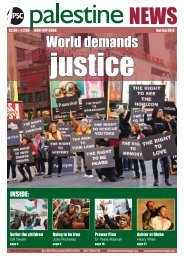InsIDe: - Palestine Solidarity Campaign
InsIDe: - Palestine Solidarity Campaign
InsIDe: - Palestine Solidarity Campaign
Create successful ePaper yourself
Turn your PDF publications into a flip-book with our unique Google optimized e-Paper software.
spring2011 reportspalestine news 11Costing the occupationShir Hever, economic researcherfor the Palestinian-Israeli organisation,The Alternative Information Centre,spent six years examining the costs ofthe occupation to write his book, ThePolitical Economy of Israel’s Occupation. He met upwith <strong>Palestine</strong> News during a UK speaking tour.Despite the vast amount of aid whichis poured into its coffers annually bythe US, running the occupation is nolonger a profitable business for Israel,according to Shir Hever.By his estimation, the Israeli governmentspends $3 billion a year on subsidies tosettlers and $6 billion a year on security.The total of $9 billion counts for 9% of thenational budget.“This is not the entire cost of runningthe colonies. It is just the extra funds thatare used to subsidise them, on top of whatsimilar communities would cost to run ifthey were inside Israel,” he says.“And the cost is increasing very fast. Myestimates were based on 480,000 settlersand there are now over half a million. Thecolonies are growing at a rate of 7% a yearbecause of all the subsidies.”Hever reckons that since 1967 Israelhas received $135 billion in aid from theUS while he calculates that the occupationhas had a net cost of around $100 billion.These figures reflect the fact that for the first20 years Israel profited economically fromoppressing the Palestinians. Now, he says,the situation has reversed.The US government ploughs $3 billion ayear into Israel in order to keep a foothold inthe Middle East. But Hever says the moneymostly acts as a subsidy to Americanmilitary manufacturers since Israel has tospend it on buying US weaponry.The additional deluge of annualdonations from Jewish organisations whichqualify for tax breaks around the world areharder to track and this money benefits theIsraeli economy more as it is spent withinthe country.“It is your money thatis being used to assistthe Palestinians and youshould look at what it isbeing used for”When he set out to research theeconomics of the occupation, Hever sayshe soon realised that the complex realitywas no respecter of borders and involvedmany different countries. “It is relevant tothe British too. It is your money that is beingused to assist the Palestinians and youshould look at what it is being used for,” hesays.Israel is the highest per capita recipientof aid in the world. Egypt comes secondafter the US pledged to hand over 60% ofthe same subsidy when it signed the peacetreaty with Israel in 1978. Financial supportto the Palestinians comes not far behind.When the Palestinian Authority wasThe remains of the EU-funded Gaza International Airport in Rafah. Photo by KaiWiedenhofer (see p27)being formed in 1994, Hever says theEuropean Union made a “strategic decision”to support the two state solution. “A lotof European countries have a lot to gaineconomically from peace in the MiddleEast,” he says.“But they were unwilling to put sanctionson Israel to force it to implement the Osloaccords. So they provided money to builda Palestinian state without any guaranteesthat it would be used for that. It was allcarrot and no stick.”After the second intifada began in2000, donors reacted by doubling aid tothe Palestinians but switching the bulkof it from development to humanitarianprojects. “By doing this they are taking onthe burden that belongs to Israel which hasthe responsibility under humanitarian law oflooking after the people it occupies.”Between 1994 and 2007 around $7 billionwas spent on development projects, mostlyby the EU but also by Japan, the US andArab countries, but “the overall effect wasnegative,” says Hever, because so many ofthe projects have been destroyed, mostly byUS-made weapons.The occupation has many other costsincluding the expense to neighbouringnations of hosting Palestinian refugees,most of whom are unemployed, and thecost to the UN of education and healthcare — UNRWA spends $600 million a yearsubsidising the occupation by providingsuch services.Four “industrial zones” which aresupposed to boost the Palestinianeconomy are being developed, two paidfor by the French government, one byGermany and one by Japan. They areexpected to employ a total of 20,000people; wages will be fixed and no unionswill be allowed, Hever says.“It is a far cry from what the Palestinianeconomy needs — 20,000 new jobs need tobe created every year just to keep pace withpopulation growth so the zones won’t makea big impact.”Up to now the Israeli public has beenprepared to accept the costs of theoccupation, but Hever wonders why therest of the world should do the same. “InEurope people should be asking their MEPswhether the projectsyou are paying to buildare being destroyed bythe Israelis.”• The PoliticalEconomy of Israel'sOccupation:Repression BeyondExploitation, by ShirHever. Published byPluto Press.







